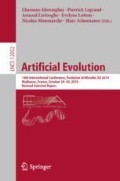Abstract
Feature selection is the process of choosing, or removing, features to obtain the most informative feature subset of minimal size. Such subsets are used to improve performance of machine learning algorithms and enable human understanding of the results. Approaches to feature selection in literature exploit several optimization algorithms. Multi-objective methods also have been proposed, minimizing at the same time the number of features and the error. While most approaches assess error resorting to the average of a stochastic K-fold cross-validation, comparing averages might be misleading. In this paper, we show how feature subsets with different average error might in fact be non-separable when compared using a statistical test. Following this idea, clusters of non-separable optimal feature subsets are identified. The performance in feature selection can thus be evaluated by verifying how many of these optimal feature subsets an algorithm is able to identify. We thus propose a multi-objective optimization approach to feature selection, EvoFS, with the objectives to i. minimize feature subset size, ii. minimize test error on a 10-fold cross-validation using a specific classifier, iii. maximize the analysis of variance value of the lowest-performing feature in the set. Experiments on classification datasets whose feature subsets can be exhaustively evaluated show that our approach is able to always find the best feature subsets. Further experiments on a high-dimensional classification dataset, that cannot be exhaustively analyzed, show that our approach is able to find more optimal feature subsets than state-of-the-art feature selection algorithms.
Access this chapter
Tax calculation will be finalised at checkout
Purchases are for personal use only
Notes
- 1.
- 2.
Intel® Core™ i7-8750H 2.20 GHz, 8 GB RAM.
References
Cilia, N.D., De Stefano, C., Fontanella, F., Scotto di Freca, A.: Variable-length representation for EC-based feature selection in high-dimensional data. In: Kaufmann, P., Castillo, P.A. (eds.) EvoApplications 2019. LNCS, vol. 11454, pp. 325–340. Springer, Cham (2019). https://doi.org/10.1007/978-3-030-16692-2_22
Xue, B., Zhang, M., Browne, W.N., Yao, X.: A survey on evolutionary computation approaches to feature selection. IEEE Trans. Evol. Comput. 20(4), 606–626 (2015)
Hamdani, T.M., Won, J.-M., Alimi, A.M., Karray, F.: Multi-objective feature selection with NSGA II. In: Beliczynski, B., Dzielinski, A., Iwanowski, M., Ribeiro, B. (eds.) ICANNGA 2007. LNCS, vol. 4431, pp. 240–247. Springer, Heidelberg (2007). https://doi.org/10.1007/978-3-540-71618-1_27
Xue, B., Fu, W., Zhang, M.: Multi-objective feature selection in classification: a differential evolution approach. In: Dick, G.G., et al. (eds.) SEAL 2014. LNCS, vol. 8886, pp. 516–528. Springer, Cham (2014). https://doi.org/10.1007/978-3-319-13563-2_44
Vignolo, L.D., Milone, D.H., Scharcanski, J.: Feature selection for face recognition based on multi-objective evolutionary wrappers. Expert Syst. Appl. 40(13), 5077–5084 (2013)
Zhou, Z., Li, S., Qin, G., Folkert, M., Jiang, S., Wang, J.: Multi-objective based radiomic feature selection for lesion malignancy classification. IEEE J. Biomed. Health Inform. 24, 194–204 (2019)
Fan, Y.J., Kamath, C.: On the selection of dimension reduction techniques for scientific applications (2012). 10.2172/1036865. part of the Annals of Information Systems book series (AOIS, volume 17)
Bermingham, M., et al.: Application of high-dimensional feature selection: evaluation for genomic prediction in man. Sci. Rep. 5, 10312 (2015). https://doi.org/10.1038/srep10312
Tsai, F.S.: Dimensionality reduction for computer facial animation. Expert Syst. Appl. 39(5), 4965–4971 (2012). https://doi.org/10.1016/j.eswa.2011.10.018
Guyon, I., Elisseeff, A.: An introduction to variable and feature selection. J. Mach. Learn. Res. 3, 1157–1182 (2003)
Lewis, P.: The characteristic selection problem in recognition systems. IRE Trans. Inf. Theory 8(2), 171–178 (1962)
Chien, Y., Fu, K.S.: On the generalized Karhunen-Loève expansion (Corresp.). IEEE Trans. Inf. Theory 13(3), 518–520 (1967)
Weston, J., Mukherjee, S., Chapelle, O., Pontil, M., Poggio, T., Vapnik, V.: Feature selection for SVMs. In: Advances in Neural Information Processing Systems 13, pp. 668–674. MIT Press (2000)
Kozachenko, L., Leonenko, N.N.: Sample estimate of the entropy of a random vector. Problemy Peredachi Informatsii 23(2), 9–16 (1987)
Fisher, R.A.: XV-the correlation between relatives on the supposition of mendelian inheritance. Earth Environ. Sci. Trans. R. Soc. Edinb. 52(2), 399–433 (1919)
Deb, K., Pratap, A., Agarwal, S., Meyarivan, T.: A fast and elitist multiobjective genetic algorithm: NSGA-II. IEEE Trans. Evol. Comput. 6(2), 182–197 (2002)
Heiman, G.W.: Understanding Research Methods and Statistics: An Integrated Introduction for Psychology. Mifflin and Company, Houghton (2001)
Cox, D.R.: The regression analysis of binary sequences. J. Roy. Stat. Soc. Ser. B (Methodol.) 20(2), 215–232 (1958)
Guyon, I., Weston, J., Barnhill, S., Vapnik, V.: Gene selection for cancer classification using support vector machines. Mach. Learn. 46(1–3), 389–422 (2002)
Welch, B.L.: The generalization of student’s problem when several different population variances are involved. Biometrika 34(1/2), 28–35 (1947)
Krzywinski, M., Altman, N.: Points of significance: comparing samples-part I. Nat. Methods 11(3), 215 (2014)
Pedregosa, F., et al.: Scikit-learn: machine learning in Python. J. Mach. Learn. Res. 12, 2825–2830 (2011)
Casalicchio, G., et al.: OpenML: an R package to connect to the machine learning platform OpenML. Comput. Statistics 34(3), 977–991 (2017). https://doi.org/10.1007/s00180-017-0742-2
Garrett, A.: inspyred (version 1.0.1) inspired intelligence (2012). https://github.com/aarongarrett/inspyred
Vanschoren, J., van Rijn, J.N., Bischl, B., Torgo, L.: OpenML: networked science in machine learning. SIGKDD Explor. 15(2), 49–60 (2013). https://doi.org/10.1145/2641190.2641198
Dua, D., Graff, C.: UCI machine learning repository (2017). http://archive.ics.uci.edu/ml
Quinlan, J.R.: Simplifying decision trees. Int. J. Man Mach. Stud. 27(3), 221–234 (1987)
Siebert, J.P.: Vehicle recognition using rule based methods (1987)
Guyon, I., Gunn, S., Ben-Hur, A., Dror, G.: Result analysis of the NIPS 2003 feature selection challenge. In: Advances in Neural Information Processing Systems, pp. 545–552 (2005)
Guyon, I.: Design of experiments of the NIPS 2003 variable selection benchmark. In: NIPS 2003 Workshop on Feature Extraction and Feature Selection (2003)
Author information
Authors and Affiliations
Corresponding author
Editor information
Editors and Affiliations
Rights and permissions
Copyright information
© 2020 Springer Nature Switzerland AG
About this paper
Cite this paper
Barbiero, P., Lutton, E., Squillero, G., Tonda, A. (2020). A Novel Outlook on Feature Selection as a Multi-objective Problem. In: Idoumghar, L., Legrand, P., Liefooghe, A., Lutton, E., Monmarché, N., Schoenauer, M. (eds) Artificial Evolution. EA 2019. Lecture Notes in Computer Science(), vol 12052. Springer, Cham. https://doi.org/10.1007/978-3-030-45715-0_6
Download citation
DOI: https://doi.org/10.1007/978-3-030-45715-0_6
Published:
Publisher Name: Springer, Cham
Print ISBN: 978-3-030-45714-3
Online ISBN: 978-3-030-45715-0
eBook Packages: Computer ScienceComputer Science (R0)

